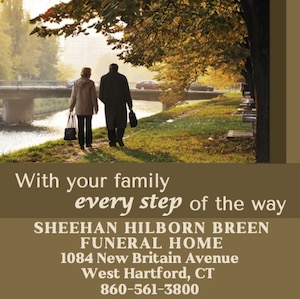
The ceiling contains a skylight surrounded by wooden beams that form an enormous Star of David, salvaged from old factories in Bridgeport.
When Steve Lloyd was commissioned as the architect for the new synagogue building, it was to be his first. After graduating from the Cornell University department of architecture in 1972, Lloyd worked for two years as an architect and regional planner in Tunisia with the Peace Corps. He returned to the U.S. and was part of several architectural firms before settling in Chester and opening his own practice in 1986. He has served as a professor, juror, and critic at several schools of architecture.
Lloyd spoke with the Ledger about how he became involved in the Congregation Beth Shalom Rodfe Zedek project and how the design took shape.
Q: How did you get involved in this project?
A: I have served as architect for several local institutions, including the Parish Hall Addition to the First Congregational Church of Old Lyme, Becker House at Connecticut College (with Roth and Moore Architects) and Temple Sinai Addition and Renovation in Newington.
I became involved in the CBSRZ project after working with Sol and Carol LeWitt on the redesign of an existing warehouse to house their art collection. It felt easy to sketch with them in my office looking at how best to configure the elements of their program. At the synagogue I was hired in 1998. Sol LeWitt had also prepared a floor plan, but it had not been presented. I proposed a series of workshops to engage members of the congregation and to solicit information as to their opinions about the site, the program and the imagery of the future building.
Q: In light of the fact that you hadn’t had experience in synagogue design, how did you approach the project? Where did you draw inspiration from?
A: One of the characteristics of synagogue design in the U.S. is a freedom from established historical forms. The design of this building evolved partly from the desires of the congregation and the nature of the site. One of the results of the workshops was a clear desire on the part of the congregation for a “hamish” building and an image of a timber frame interior was the most popular. This was consistent with the site that is on acreage once belonging to the Warner estate. The Warner House, now on an adjacent parcel, is one of Chester’s most important historic houses. To place a barn-like timber frame structure behind it felt like a respectful gesture.
In addition, precedents played an important role. Sol had seen the Louis Kahn-designed synagogue in Katonah, N.Y., which featured an octagonal sanctuary. That design was inspired by Eastern European wooden synagogues in the shtetls, now almost all lost. In particular, the beautiful 18th-century synagogue in Wolpa, Poland we found to be compelling. It had also inspired the design of the National Yiddish Book Center at Hampshire College, which members of the congregation had visited and admired.
My task, then, was to seek ways to fulfill the functional needs of a modern congregation while creating a building reminiscent of older, simpler structures and offering the warmth that people wanted in their new spiritual home – as well as keeping in mind the plan that Sol had drawn.
Q: Describe your and Sol LeWitt’s design process.
A: By listening to the concerns of the design committee, I learned the importance of centering the worship experience to the east, and the importance of sunset as the beginning of the Sabbath. We discussed the best ways to allow for an intimate sanctuary – as in their previous shul in Deep River – for weekly use and then expanding the space for High Holy Days.
Sol would call me when he had something to show me. It was always a pleasure to visit him in his studio. There might be a beautiful new gouache pinned to the wall. Sol was very interested in the form of the sanctuary and early in the process he carefully drafted an elevation showing an octagonal structure with a sloping roof approximating a dome, along with a harmonious shape for the library/chapel. Later, once the final plan had taken shape, he placed tracing paper over my elevation drawing and sketched a rough skewed shape to make the roof asymmetrical and focus light on the bimah. I think this gentle pushing of the shape is one of the most successful elements of the design, offering not only functional delivery of light but also a unique and dynamic roof structure.
Q: What were some highlights for you as a designer?
A: The use of recycled replaned timber for the sanctuary is a highlight of the completed building. The wood speaks of sustainability and respect for nature. Its geometry is complex, rising from an octagonal base to a hexagon at clerestory level where a timber Star of David is incorporated, and finally to central square skylight. But the wood is warm, as the congregation wished. During construction, after the roof was on the sanctuary but while there was still scaffolding inside, I climbed up with Sol and Carol to experience a level of intimacy with the exposed frame that would not be possible later from the floor. Sol said simply, “This is nice,” which felt like a huge compliment.
Toward the end of construction Sol asked to meet me at the building. He had brought a mock-up of his design for a multicolored Star of David inscribed in a circle and he asked if I thought it could work on one of the removable panels at the rear of the sanctuary. It was a spectacular piece, full of energy. I said “No, I don’t think so, Sol. It has to go in front, on the Ark.” It was placed on the biparting doors that reveal the Torahs and has become a symbol for the congregation.
Q: Have you visited the building over the last decade?
A: I have been to the synagogue several times since its completion. I have given tours to friends and people wishing to write about or film the building. I have been to funerals, including Sol’s, when the building has literally overflowed with love and sadness. I have been to story-tellings and author readings and have even heard a Metropolitan Opera baritone sing, animating the sanctuary with an energy to rival Sol’s star.
I have also been in the sanctuary alone on a sunny day, watching as the patterns of sun and shadow move over the white walls. It is hard to say what makes a building or a space special, much less spiritual. My former boss, architect Charles Moore, used to say that a building is as good as the energy expended in its creation. In the case of Beth Shalom Rodfe Zekek, great energy was contributed by the congregation along the way, before, during and after construction. That energy resides and grows in the sanctuary as the shadows move according to the sun and the seasons.








 Southern New England Jewish Ledger
Southern New England Jewish Ledger








